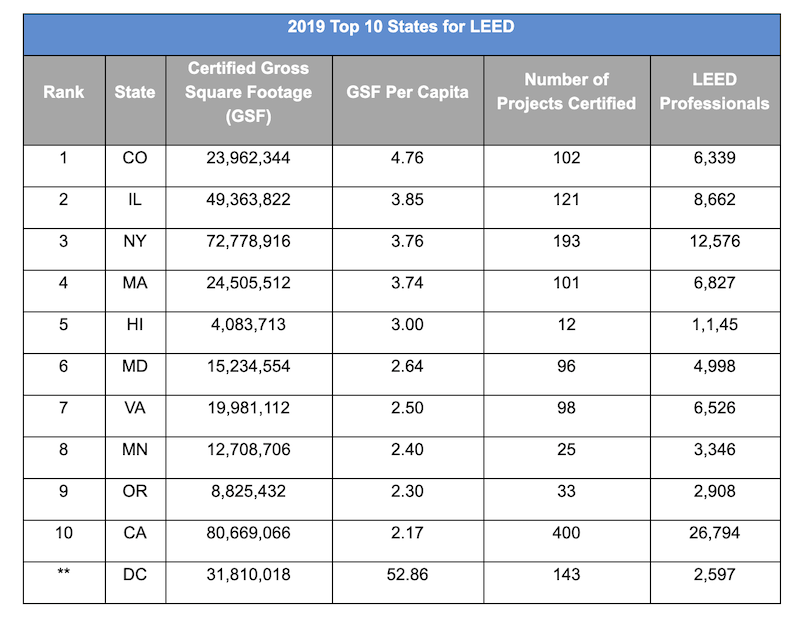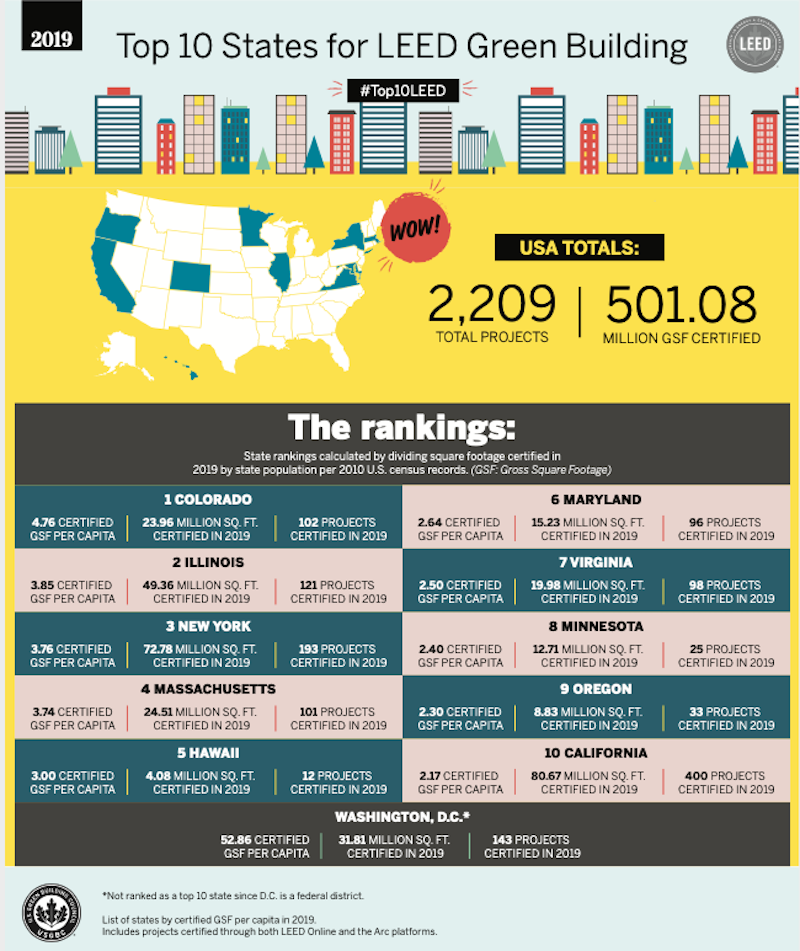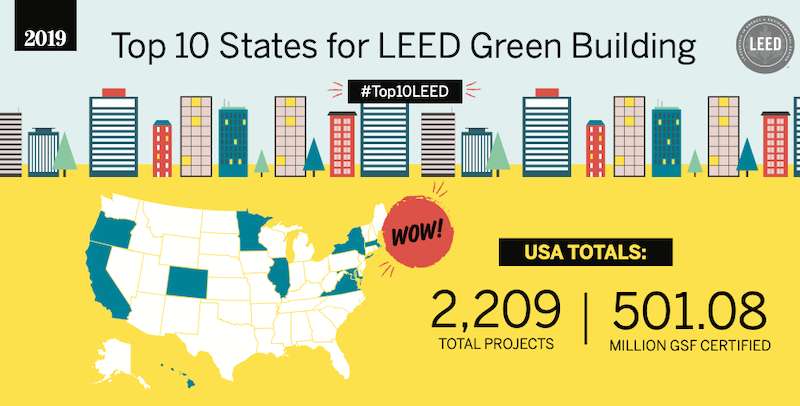As cities and states continue to work toward climate action goals, the U.S. Green Building Council (USGBC) has announced its list of Top 10 States for LEED green building. For the first time since 2011, Colorado took the top spot on the list, which ranks states based on the number of LEED certified square feet per person. LEED, or Leadership in Energy and Environmental Design, is the most widely used green building rating system in the world with more than 100,000 projects engaged. This year’s top states are home to more than 105 million people, including more than 80,000 LEED green building professionals with the skills to support the sustainable transformation of buildings.
“As we embark on a new decade, the USGBC community is focused on helping more projects get on the path to LEED certification and a more sustainable future,” said Mahesh Ramanujam, president and CEO, USGBC. “Over the last year, the Top 10 states have certified projects that serve as incredible examples of how green building can create more sustainable and resilient spaces that improve our living standard. There is still much work to be done, but the progress made across these states shows us that our work is having a tangible impact on people’s lives. As we enter our next chapter, we are committed to helping more buildings, cities and communities improve their sustainability performance through LEED.”
LEED-certified projects support personal health and well-being, as well as use less energy and water, reduce carbon emissions and save money for families, businesses and taxpayers. The Top 10 list is based on 2010 U.S. Census data and includes commercial and institutional green building projects certified throughout 2019. Colorado certified 102 green building projects representing 4.76 square feet of LEED-certified space per resident. The state has made the Top 10 list each year but jumped to the top spot after ranking sixth in 2018. Minnesota and Oregon reemerged as Top 10 states after missing the list last year, coming in at number eight and nine respectively. The full rankings are as follows:

USGBC calculates the list using per capita figures to allow for a fair comparison of the level of green building taking place among states with significant differences in population and number of overall buildings. Despite Washington, D.C. not appearing in the official Top 10 list because of its status as a federal territory, it consistently leads the nation and in 2019 certified 52.86 square feet of space per resident across 143 green building projects. The nation’s capital has a strong legacy of sustainability leadership and has expanded its use of LEED from buildings to cities and communities to support its goals. In 2017, it became the first LEED-certified city and in 2019 certified the Golden Triangle Business Improvement District LEED Platinum, the first business improvement district in the world to certify.
With green building expected to grow globally through 2021, the need for skilled professionals to support green building projects has never been more important. Across the U.S. there are more than 165,000 LEED green building professionals with the knowledge to help cities and communities transition to greener buildings and spaces. LEED professionals demonstrate a competency in green building principles that can set projects on the path to certification and help them consider ways to reduce their impact on the environment and provide people with healthier, more sustainable spaces to live, learn, work and play.

As USGBC continues to advance green buildings, cities and communities through the adoption of LEED and the latest version of the rating system, LEED v4.1, the organization is also considering a future that is focused on a more regenerative approach. In November 2019 at the annual Greenbuild International Conference & Expo, USGBC introduced LEED Positive – a roadmap that will lay the foundation for a future of LEED that transitions away from strategies that only reduce harm and instead focus on those that help repair and restore. With a continued focus on performance, USGBC is laying the groundwork to ensure sustainable design, construction and operations of buildings, cities and communities remains focused on better buildings that contribute to better lives.
Related Stories
Construction Costs | Apr 18, 2024
New download: BD+C's April 2024 Market Intelligence Report
Building Design+Construction's monthly Market Intelligence Report offers a snapshot of the health of the U.S. building construction industry, including the commercial, multifamily, institutional, and industrial building sectors. This report tracks the latest metrics related to construction spending, demand for design services, contractor backlogs, and material price trends.
Market Data | Apr 16, 2024
The average U.S. contractor has 8.2 months worth of construction work in the pipeline, as of March 2024
Associated Builders and Contractors reported today that its Construction Backlog Indicator increased to 8.2 months in March from 8.1 months in February, according to an ABC member survey conducted March 20 to April 3. The reading is down 0.5 months from March 2023.
K-12 Schools | Apr 10, 2024
Surprise, surprise: Students excel in modernized K-12 school buildings
Too many of the nation’s school districts are having to make it work with less-than-ideal educational facilities. But at what cost to student performance and staff satisfaction?
Multifamily Housing | Apr 9, 2024
March reports record gains in multifamily rent growth in 20 months
Asking rents for multifamily units increased $8 during the month to $1,721; year-over-year growth grew 30 basis points to 0.9 percent—a normal seasonal growth pattern according to Yardi Matrix.
Retail Centers | Apr 4, 2024
Retail design trends: Consumers are looking for wellness in where they shop
Consumers are making lifestyle choices with wellness in mind, which ignites in them a feeling of purpose and a sense of motivation. That’s the conclusion that the architecture and design firm MG2 draws from a survey of 1,182 U.S. adult consumers the firm conducted last December about retail design and what consumers want in healthier shopping experiences.
Market Data | Apr 1, 2024
Nonresidential construction spending dips 1.0% in February, reaches $1.179 trillion
National nonresidential construction spending declined 1.0% in February, according to an Associated Builders and Contractors analysis of data published today by the U.S. Census Bureau. On a seasonally adjusted annualized basis, nonresidential spending totaled $1.179 trillion.
Market Data | Mar 26, 2024
Architecture firm billings see modest easing in February
Architecture firm billings continued to decline in February, with an AIA/Deltek Architecture Billings Index (ABI) score of 49.5 for the month. However, February’s score marks the most modest easing in billings since July 2023 and suggests that the recent slowdown may be receding.
K-12 Schools | Mar 18, 2024
New study shows connections between K-12 school modernizations, improved test scores, graduation rates
Conducted by Drexel University in conjunction with Perkins Eastman, the research study reveals K-12 school modernizations significantly impact key educational indicators, including test scores, graduation rates, and enrollment over time.
MFPRO+ News | Mar 16, 2024
Multifamily rents stable heading into spring 2024
National asking multifamily rents posted their first increase in over seven months in February. The average U.S. asking rent rose $1 to $1,713 in February 2024, up 0.6% year-over-year.
Market Data | Mar 14, 2024
Download BD+C's March 2024 Market Intelligence Report
U.S. construction spending on buildings-related work rose 1.4% in January, but project teams continue to face headwinds related to inflation, interest rates, and supply chain issues, according to Building Design+Construction's March 2024 Market Intelligence Report (free PDF download).

















